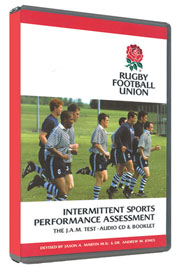The J.A.M. Intermittent Test is a test developed to measure the intermittent fitness ability of team sport athletes. There is another somewhat similar test, the Yo-Yo Intermittent test. The test was created for Rugby Union players, though it is used rarely nowadays, instead the yoyo or beep tests are more popular.
purpose: The test evaluates an individual's ability to repeatedly perform intervals over a prolonged period of time.
equipment required: Flat, non-slip surface, marking cones, measuring tape, JAM test cd (no longer available?), cd player, recording sheets.
pre-test: Explain the test procedures to the subject. Perform screening of health risks and obtain informed consent. Prepare forms and record basic information such as age, height, body weight, gender and test conditions. Measure and mark out the test area using cones. See more details of pre-test procedures.
 procedure: A full description of the test procedures is available with the cd and associated booklet. Cones need to be set out in a triangular circuit, the sides of different lengths. The test involves a series of walk–jog–run shuttles. The participants loop around the triangle, either running, walking or jogging in that order. Approximately every 2 minutes the run is replaced with a maximal 12 meter sprint bout. The test continues around a triangular circuit, with participants keeping in time with a series of audio signals. The time between beeps gets progressively shorter, and the test continues until the participants cannot longer keep up with the test
procedure: A full description of the test procedures is available with the cd and associated booklet. Cones need to be set out in a triangular circuit, the sides of different lengths. The test involves a series of walk–jog–run shuttles. The participants loop around the triangle, either running, walking or jogging in that order. Approximately every 2 minutes the run is replaced with a maximal 12 meter sprint bout. The test continues around a triangular circuit, with participants keeping in time with a series of audio signals. The time between beeps gets progressively shorter, and the test continues until the participants cannot longer keep up with the test
scoring: Your score is the time completed on the test. A minimum of 12 minutes on this test is required to get on to the National RFU TJ Panel.
target population: This test was specifically developed for assessing the fitness of Rugby Football Union Referees, but would be suitable for other team sports such as football, rugby, AFL, field hockey, team handball and basketball. The test is suitable for athletes of all levels.
reliability: The reliability would depend on how strictly the test is run, and the previous practice allowed for the participants.
advantages: The test is easy to conduct. Large groups can perform this test all at once for minimal costs (once the kit has been bought).
disadvantages: Practice and motivation levels can influence the score attained, and the scoring of when a person cannot keep in time with the test can be subjective. As the test is usually conducted outside, the environmental conditions can also affect the results.
other considerations: This test is a maximal test, which requires a reasonable level of fitness. It is not recommended for recreational athletes or people with health problems, injuries or low fitness levels.
Similar Tests
- Referee Beep Test — a modified version of the standard 20m beep test adapted for the specific demands of Rugby League referees.
- Assistant Referee Intermittent Endurance Test (ARIET) — an intermittent yo-yo type test involving forwards and sideways running created specifically for football (soccer) assistant referees.
- Dynamic Yo-Yo Test — a modified yo-yo test designed specifically for football (soccer) referees
Related Pages
- Fitness testing for field officials (umpires, referees)
- About Testing for Intermittent Sports
- The complete guide to the beep test for links to more information.
- About the Sport of Rugby Union.


 Current Events
Current Events